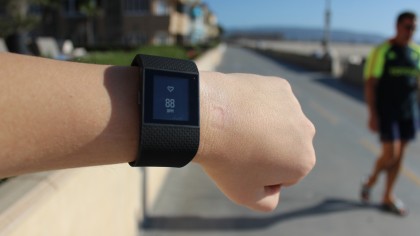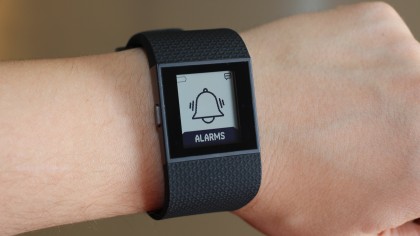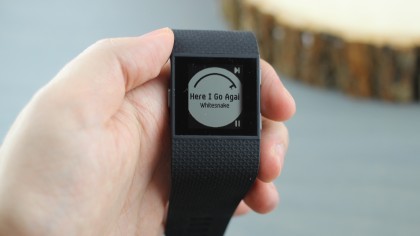Why you can trust TechRadar
Coupled with the runner-friendly GPS feature, the Fitbit Surge has a heart-rate monitor that constantly tracks your heartbeat for what the company calls a "PurePulse."

Really, it's an optical heart rate monitor that sits on the underside of the watch and reflects a pair of green LEDs off of your skin to calculate changes in blood volume.
This HRM technology is no different to what's found in the Fitbit Charge HR, which keeps tabs on your beats per minute. But the Surge does have a helpful trailing BPM indicator on the LCD.
And it's wholly better than the heart monitors found in earlier fitness trackers, like the Withings Pulse O2. Those forced users to pause to calculate their heart rate.

Fitbit Surge's heart rate monitor constantly measures your beats per minute and is accurate unless you're extremely active. It does a better job with that all-important resting heart rate.
Of course, I've always found the chest-mounted Polar Smart Heart Rate Sensor more accurate than any wrist-worn HRM. But as an all-in-one solution, this Fitbit works fine in most conditions.
Its always-on LCD also fixes the problem we had with the Fitbit Charge HR heart rate monitor. That version's display went to sleep, complicating running and actively watching your BPM.
Sign up for breaking news, reviews, opinion, top tech deals, and more.
Sleep tracking
Sleep tracking, when it works, is a bonus feature that's just as important as any wide-awake health metric. The problem is that it doesn't always work in fitness trackers.

Jawbone Up24 is the perfect example. It logs fairly accurate wake/light sleep/deep sleep stats for us, but too often we forget to set it to the sleep mode. Or forget to wake it in the morning.
Fitbit Surge remedies that with automatic sleep detection that starts logging sleep within minutes of dozing off.
It sure beats having to set the band into sleep mode with a long press of a button. That was always a little backwards and now it's fixed. The only thing you need to set is the convenient silent alarm that vibrates to wake you and not the person next to you.
Sadly, Fitbit is known for providing a very basic sleep timeline: asleep in blue, restless in aqua and awake in pink. Worse, Fitbit Surge's patterns don't always reflect other trackers.

I found it harder to read my overly simplistic sleep timeline vs the minute-by-minute sleep analysis provided by the Jawbone Up24 and Basis Peak sleep tracker.
What the Fitbit line really needs is a new way of displaying the sleep tracking data it collects. Its scrunched-up timeline is hard to read, so the automatic sleep detection is less meaningful.
Fitbit Surge's sleep tracking feature is a fantastic idea, one that's just as important as steps, but it doesn't follow through with anything that can be considered accurate or helpful.
Update: Since we originally reviewed the Surge, Fitbit has introduced Sleep Schedule, which not only tracks sleep, but helps you decide when you should be waking up and going to bed to have the healthiest lifestyle possible.
The Sleep Schedule lives in Fitbit's companion app and is a small, but thoughtful addition that should keep Fitbit users interested.
Smartwatch features
Fitbit Surge comes through with overdue smartwatch capabilities in a big way, thanks to its oversized square display.

This shows a scrolling Caller ID from incoming calls and SMS alerts that can be read in full. Is a call or text worth pulling your phone out of your pocket or should you keep on running?
The Fitbit Surge solves that problem and also gives you control over your mobile music with a few swipes or taps on the new wristwatch.

Double tapping the left button brings up a hidden menu for interfacing with your phone's music. I used Google Play Music and could skip tracks, pause and play music.
Music playback did require enabling Bluetooth Classic, which was confusing at first and drains the battery quick. But it was effective once I re-synced the watch to my phone.
Just don't expect to store music on the watch itself. Fitbit Surge is large enough and doesn't need internal storage to make it even bigger.
Fitbit Surge compatibility
Chances are, if you own a modern day smartphone, Fitbit Surge works with it. That's because the necessary app is compatible with iOS, Android and Windows Phone handsets.

Fitbit is the first mainstream wearable manufacturer to invite Microsoft's loyal customers into the fitness stats-syncing fold, and it actually goes a step further on Windows Phone 8.1.
Testing it out on my Nokia Lumia 830, I was able to tell Cortana to log food and activities with the sound of my voice. Saying "Fitbit, I ate a salad for lunch" searched the database of 350,000 foods.
This would make Microsoft's platform the ideal choice for Fitbit users, but food logging is still too complicated in the end. I was forced to describe the salad and its size to a nauseating degree.
The Fitbit ecosystem is all-around more inclusive except when it comes to Apple Health. Sadly, the fitness-focused startup as opted out of syncing its data with iPhone's wellness app.
Current page: Heart rate monitor, sleep and smartwatch features
Prev Page What's it like as a running watch? Next Page Waterproof, battery life and verdict
